Quebec is the capital of the French-speaking Canadian province of the same name as the city. After Montreal, it is the province’s largest city and it offers numerous sights and activities for locals and visitors alike.
Founded in 1608, the city is Canada’s second oldest city. In early Québec, walls and fortifications were built around the city according to European model, and they can still be seen as the only one of its kind in the United States and Canada. The walls surround the old town, Vieux-Québec, which is included in the UNESCO World Heritage List.
Québec’s skyline is dominated by the impressive and castle-like hotel Château Frontenac, which stands as one of the country’s famous old railway hotels. Below the hotel you can see more of the city’s history in the interesting citadel, which today hosts the residence of the Canadian monarch.
You can also visit several interesting museums in Quebec, such as the city’s national art museum. There are also lovely, recreational areas with the city’s many green parks and the entire area along the St Lawrence River, which flows around the island of île d’Orléans just east of downtown Quebec.
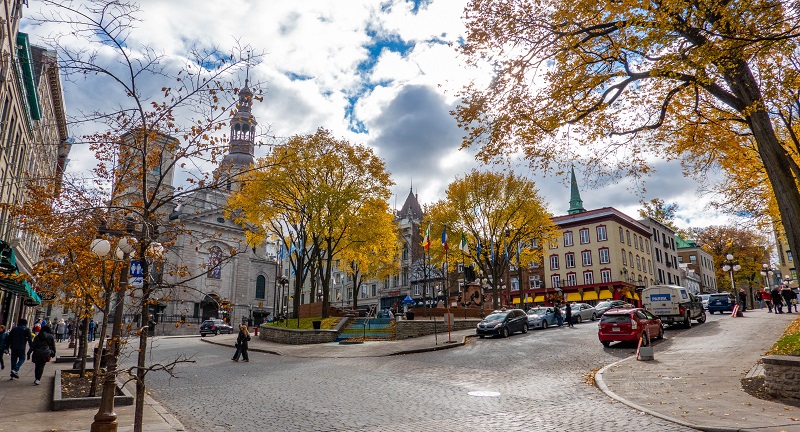
Vieux-Québec is the name of the old quarter of the city of Québec. Vieux-Québec consists of the Upper Town/Haute-Ville and the Lower Town/Basse-Ville neighborhoods, and the area is on the UNESCO World Heritage List. All of Vieux-Québec is worth seeing with cozy squares and many interesting buildings and architecture.
Samuel de Champlain chose the hill of Cap Diamant and Haute-Ville as the site of Fort Saint-Louis in 1608, and it has remained the administrative center of the city since then. Most of the buildings date from the 1800s, but there are also older structures here. In the neighborhood you can see Québec’s town hall from 1896 among many structures.
Basse-Ville is north and east of Haute-Ville and below the Cap Diamant hill. It was here that Samuel de Champlain established the Habitation de Québec as the actual settlement for immigrants. It was located around the current Place Royale. In the neighborhood you will find a number of buildings from early Quebec, such as the church of Notre-Dame-des-Victoires, which was built from 1687 to 1723.
There are many individual sights in Vieux-Québec, but during a visit to the city it is also recommended to simply take a walk in the streets and in the district’s fine squares such as Place de l’Hôtel de Ville and Place d’Armes, where you can go to the promenade Terrasse Dufferin. From here there is a lovely view of St. Lawrence River.
Notre-Dame de Québec is the main Catholic church in the city of Québec. The church is also one of the oldest in Canada, as the first version of Notre-Dame was already built from 1647. It happened on the site where Samuel de Champlain had built the Notre Dame de la Recouvrance chapel in 1633.
The 1647 church was called Notre-Dame de la Paix, and it burned twice, one time was during the siege of Québec in 1759. Repeatedly since then, Notre-Dame has been rebuilt, which for example took place in the middle of the 19th century with a neoclassical facade. The church was elevated to a basilica by the Pope in 1874.
Notre-Dame de Québec is worth seeing with its exterior and as a historic church building. It is also worth seeing with the richly decorated interior, where you can see some graves of famous people in the region’s early development. Louis du Buade, Louis-Hector, Jacques-Pierre de Taffanel de La Jonquière and Philippe de Rigaud de Vaudreuil, all four of whom were governors of Nouvelle-France, are buried here.
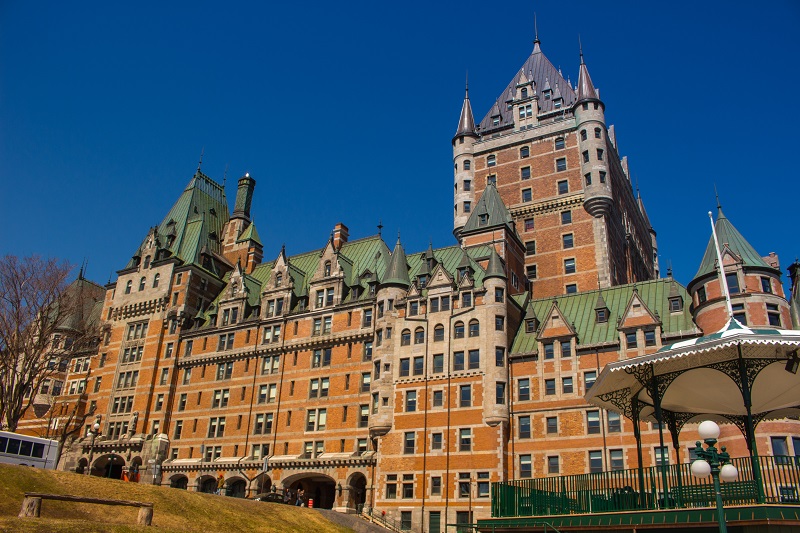
Château Frontenac is a castle-like hotel that stands majestically as Québec’s most important landmark. The impressive hotel is one of many hotels in French château architecture that were built along the Trans-Canadian Railway in the decades around 1900, when the railways wanted to develop traffic and offer a comfortable accommodation for their guests and travelers.
Château Frontenac opened in 1893 as a railway hotel built by the Canadian Pacific Railway. It was the American architect Bruce Price who designed the hotel, which was one of the first of these great luxury hotels. The style is grand and with a height of almost 80 meters, which was built on a 54 meter high hill, the hotel defines the city skyline.
The exterior of the hotel looks almost fairytale-like with its Gothic and asymmetrical expression, which was inspired by the Victorian era. After enjoying the sight of the hotel, you can continue into Château Frontenac where you can see the unique experiences that guests had in the late 19th century with mahogany paneling, marble staircases and more.
Many of the hotel’s suites are also thematically decorated after the heads of state and government who have visited the hotel. This is the case, for example, with the Trudeau-Trudeau Suite, the Churchill Suite and the Roosevelt Suite. There are also suites named after, for example, Charles de Gaulle and Elizabeth II, who was Queen of Canada. Finally, you can find suites with names from other celebrities such as Alfred Hitchcock.
Quartier Petit Champlain is a charming neighborhood between Cap Diamant and the bank of St. Lawrence River. Trading stations were located in the area when Québec was founded, and it is thus one of the city’s oldest areas. The original buildings were constructed of wood, but in 1759 the quarter was ruined during an English bombardment and subsequently rebuilt.
The streets of the Petit-Champlain neighborhood are almost like a journey back in time to the founding of Québec over 400 years ago. A walk on Place Royale and along Rue Petit Champlain is like an historic adventure, and it was at Place Royale that Samuel de Champlain established his settlement in 1608, the first French settlement in North America.
At the southern end of the Place Royale, Samuel de Champlain’s second house is marked in the paving in front of the Église Notre-Dame-des-Victoires church. The church itself is interesting. It was built 1687-1723 on the remains of Samuel de Champlain’s first settlement, making it one of the oldest in Canada.
From Place Royale, you can continue through the narrow cobbled streets to Rue de Petit Champlain, one of North America’s oldest shopping streets. It is also a street with an atmosphere that is difficult to find elsewhere on the continent, and at Christmas time, for example, the many cozy shops are beautifully decorated for the season.
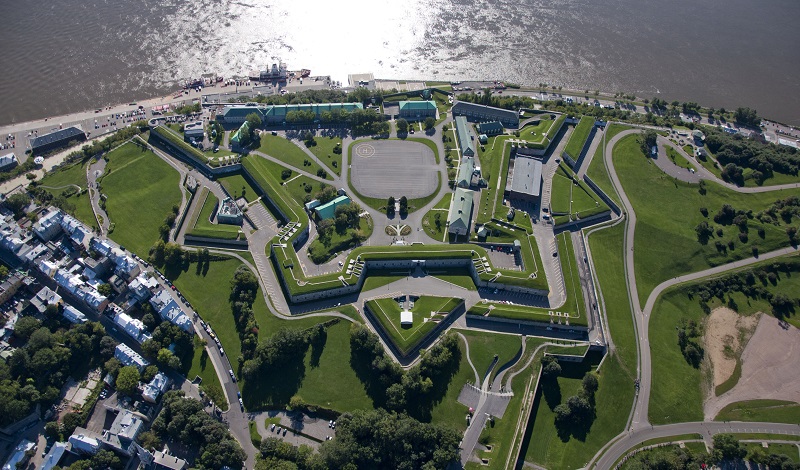
The Citadelle de Québec is an impressive fortress located in the central part of Québec City on the banks of the St Lawrence River. In addition to the military role, the citadel has the status of one of two official residences of the Canadian monarch and governor general. The other residence is Government House in Ottawa.
The large facility sits on top of the Cap Diamant hill, which was already seen as a strategically important site in 1608, when Samuel de Champlain established the first settlement and outpost in what became the city of Québec. The French established the fortification as part of the defense of Nouvelle France, and later the English expanded the complex.
The citadel that you can see today was built by the English between 1820 and 1850 as an active defense against a possible American attack on the city. The British used the Citadelle de Québec until 1871, when they transferred the citadel to the Canadian government, which continued to use the complex for military purposes.
The Citadel became historic when it set the stage for the Quebec Conference, a military strategic conference held between Mackenzie King, Franklin D. Roosevelt and Winston Churchill of Canada, the United States and Great Britain respectively in August 1943. It was also here that Roosevelt and Churchill signed the Quebec Agreement.
The Citadel is open to visitors, including access to the residence, which was built as the Officer’s Barracks in 1831. The Governor-General usually uses it for a few weeks in the summer. From the citadel you can also hear a cannon that is fired every day at noon at 12:00.
The Musée national des beaux-arts du Québec is an art museum founded in 1933 with the name Musée de la province de Québec. The museum is located in the area of Parc des Champs-de-Bataille/The Battlefields Park, which is a huge park and green space south of central Québec.
The museum’s collection includes more than 40,000 works from the 16th century to the present day. The collection primarily includes works produced in the province of Québec or by artists from Québec. In the exhibitions, you can see works from other parts of Canada and the rest of the world as well.
The museum is located in several buildings. Pavillon Gérard-Morisset was completed in 1931 as the original building, which opened in 1933. The other building adapted for the purpose was the former prison from 1867, Pavillon Charles-Baillairgé. Since then, Pavillon Central and Pavillon Pierre-Lassonde have been added.
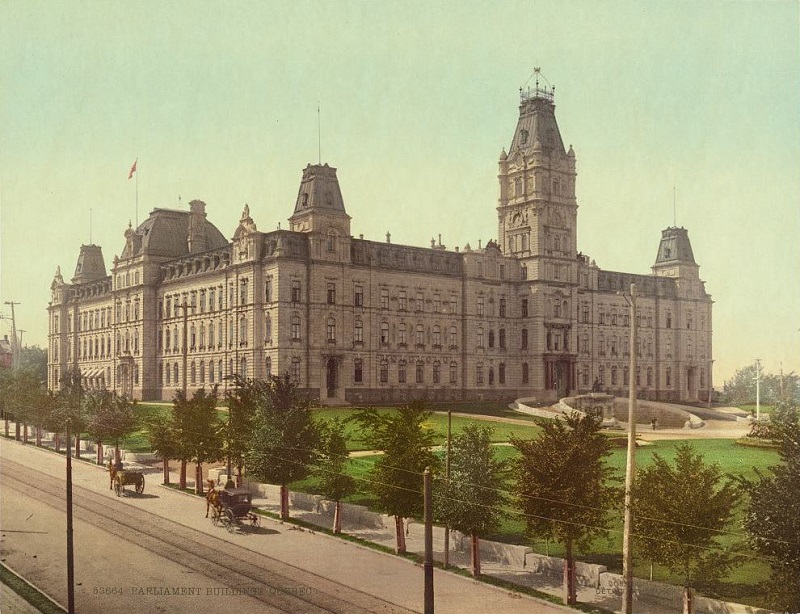
The Hôtel du Parlement is an impressive building that housed the parliament of the province of Québec, the Assemblée Nationale du Québec. There is a parliament in the city, as the city of Québec is the capital of the province. This large parliament building was built in the years 1877-1886.
The Parliament building was designed by the architect Eugène-Étienne Taché in the so-called second empire style and built in the heart of Québec on Colline Parlementaire or Parliament Hill. It is not the first parliament building in Québec, and over the years the parliament has also held meetings in, among other places, the city’s bishop’s palace.
Previous buildings and meeting places had become too small for the 19th-century development in the city, and the government proposed a new construction in 1869. For the purpose, land was acquired and plans took form. The chosen architecture was intentionally French-inspired in contrast to the British-inspired Ottawa.
Porte Saint-Louis is one of the four preserved city gates of Québec’s preserved bastions that encircle the Old Town. The other city gates are Porte Saint-Jean, Porte Kent and Porte Prescott, all of which can be seen on a nice walk around the city center.
The first version of the Porte Saint-Louis was built in 1693-1694 at the same time as the Porte Saint-Jean. The city gate was demolished around 1745 to make way for military engineer Gaspard-Joseph Chaussegros de Léry’s new walled fortifications, and in 1759 the gate was reinforced.
The appearance of the current gate originates from a reconstruction carried out in 1878-1881. It was necessary because, after the departure of the British garrison from Québec in 1871, several parts of the city’s old fortifications had been demolished.
La Fresque des Québécois is a huge trompe-l’œil-style mural that illustrates the history of Québec City and pays tribute to several notable figures from the city’s development. The gable painting is located close to Place Royale in the cozy Quartier Petit Champlain.
The painting was unveiled in 1999 and painted by twelve artists from France and Québec. In nine weeks, they created the work with notable historical figures from different periods of Québec’s past, which can be seen in fields of architecture, geography and culture that reflects other parts of the development.
Among other things, you can see Jacques Cartier and Samuel de Champlain, who were both explorers who mapped parts of northeastern North America. Jean Talon and Louis de Buade, who developed and defended Nouvelle-France, are also among those represented. You can also see François de Laval, who was the city’s first bishop.
The Funiculaire du Vieux-Québec is a funicular cable car that was established in 1879 in downtown Québec. The track connects the lower town and Quartier Petit Champlain with Terrasse Dufferin and the upper town close to Château Frontenac.
When the funicular was put into service in 1879, it was powered by a system with water as ballast. In 1907 it was converted to electric operation. It is a short trip with a length of 64 metres, but you climb 59 meters on the trip saving a lot of stairs.
Terrasse Dufferin is a panoramic terrace located at the luxury hotel Château Frontenac in Quebec’s upper town. The terrace was laid out under Governor-General Frederick Temple Hamilton-Temple-Blackwood, who held the title of Marquess of Dufferin and Ava, from which the name Terrace Dufferin came.
The terrace opened in 1879 and it quickly became a popular excursion destination for strolls due to the beautiful view that was and is from here. Along the way, you can walk in the shade of the six pavilions that line the promenade that connects Château Frontenac with the Citadelle de Québec.
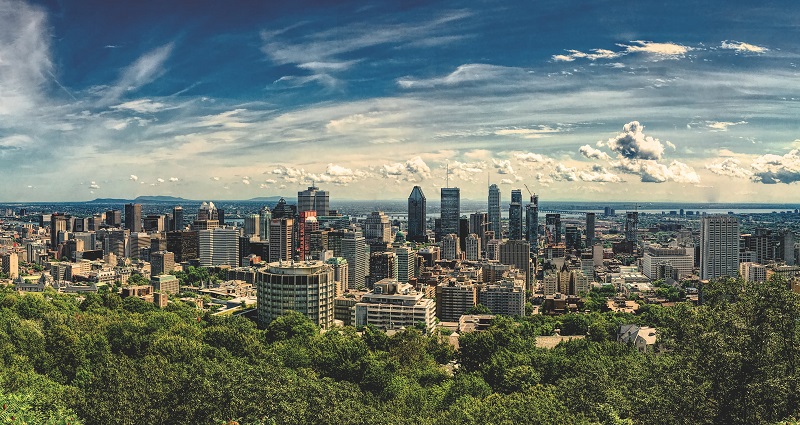
Montreal is Canada’s second largest city, and it is one of the French-speaking world’s largest cities. Montreal is also famous for design and architecture that goes far back in the city’s history. Visitors can enjoy preserved buildings dating back to the 17th century and many landmarks from the following centuries.
The Old Town offers many activities and beautiful sights. The Notre-Dame Basilica and the large Bonsecours market are two of the buildings you should definitely see, and you can also take a stroll along Rue Saint Jacques to see some 19th century headquarters for Canada’s major banks.
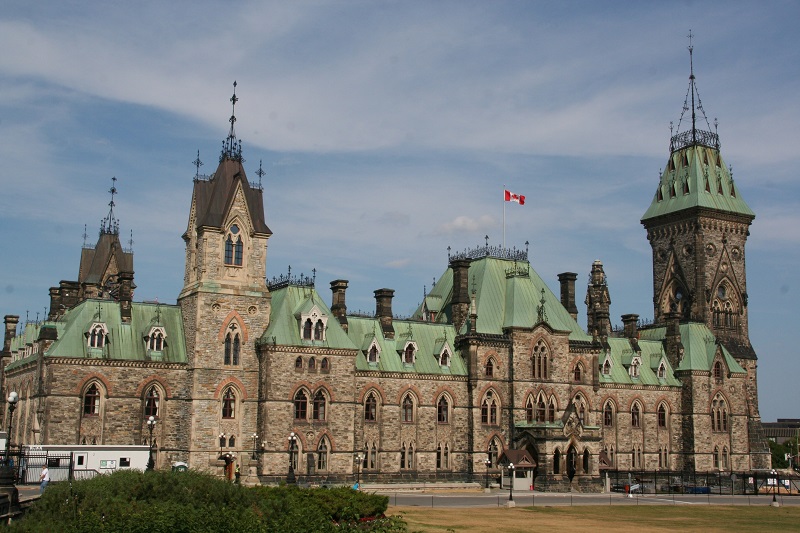
Ottawa is Canada’s capital and it is located in Ontario on the border between English-speaking and French-speaking Canada. Thus, on the opposite bank of the Ottawa River is the town of Gatineau, which is part of the metropolitan area surrounding the capital.
In Ottawa there are many sights, and of course the Canadian government buildings are among the best known. The main building on Parliament Hill is the so-called Center Block, which stands in neo-Gothic architecture, that is clearly seen inside, for example, in the Confederation Hall and in the Hall of Honor.
Read more about Ottawa
5401 Blvd des Galeries
galeriesdelacapitale.com
2700 Blvd Laurier
laurierquebec.com
43 Rue de Buade
2600 Blvd Laurier
placedelacite.com
552 Blvd Wilfrid-Hamel
placefleurdelys.qc.ca
2452 Blvd Laurier
placestefoy.com
Quartier Petit Champlain, Place Royale, Viuex-Port, Vieux-Québec
Mega Parc des Galleries de la Capitale
5401 Blvd des Galleries
mega-parc.com
Village Vacances Valcartier
1860 Blvd Valcartier
valcartier.com
The city of Québec is the oldest city in French Canada. It was founded in 1608 and contains a number of buildings and an atmosphere that can draw the minds of Europe. Quebec is founded as a city and not like many other settlements that were trading stations.
Already in 1535, attempts had been made to establish a permanent settlement, a fort was built and after some habitation, it was abandoned in 1542.
The city and thus the French colony fell to the English in 1759, and Quebec officially became part of the British colony four years later. At that time, the city had about 8,000 inhabitants, and in terms of building, there were several defense positions and monumental architectural works.
More recently, Quebec hosted two World War II summits. In 1943, US President Franklin D. Roosevelt met with Prime Ministers of Great Britain and Canada, Winston Churchill and William Lyon Mackenzie King, and Chinese Foreign Minister Soong. The following year, Roosevelt and Churchill met again in the city.
Québec has maintained its French culture over time, and today almost the entire population of the city is thus French-speaking.

Overview of Quebec
Quebec is the capital of the French-speaking Canadian province of the same name as the city. After Montreal, it is the province’s largest city and it offers numerous sights and activities for locals and visitors alike.
Founded in 1608, the city is Canada’s second oldest city. In early times, walls and fortifications were built around the city according to European model, and they can still be seen as the only one of its kind in the United States and Canada. The walls surround the old town, which is included in the UNESCO World Heritage List.
About the upcoming Quebec travel guide
About the travel guide
The Quebec travel guide gives you an overview of the sights and activities of the Canadian city. Read about top sights and other sights, and get a tour guide with tour suggestions and detailed descriptions of all the city’s most important churches, monuments, mansions, museums, etc.
Quebec is waiting for you, and at vamados.com you can also find cheap flights and great deals on hotels for your trip. You just select your travel dates and then you get flight and accommodation suggestions in and around the city.
Read more about Quebec and Canada
Buy the travel guide
Click the “Add to Cart” button to purchase the travel guide. After that you will come to the payment, where you enter the purchase and payment information. Upon payment of the travel guide, you will immediately receive a receipt with a link to download your purchase. You can download the travel guide immediately or use the download link in the email later.
Use the travel guide
When you buy the travel guide to Quebec you get the book online so you can have it on your phone, tablet or computer – and of course you can choose to print it. Use the maps and tour suggestions and you will have a good and content-rich journey.
Fine Museums • Notre-Dame • Vieux-Québec • Château Frontenac

Overview of Quebec
Quebec is the capital of the French-speaking Canadian province of the same name as the city. After Montreal, it is the province’s largest city and it offers numerous sights and activities for locals and visitors alike.
Founded in 1608, the city is Canada’s second oldest city. In early times, walls and fortifications were built around the city according to European model, and they can still be seen as the only one of its kind in the United States and Canada. The walls surround the old town, which is included in the UNESCO World Heritage List.
About the upcoming Quebec travel guide
About the travel guide
The Quebec travel guide gives you an overview of the sights and activities of the Canadian city. Read about top sights and other sights, and get a tour guide with tour suggestions and detailed descriptions of all the city’s most important churches, monuments, mansions, museums, etc.
Quebec is waiting for you, and at vamados.com you can also find cheap flights and great deals on hotels for your trip. You just select your travel dates and then you get flight and accommodation suggestions in and around the city.
Read more about Quebec and Canada
Buy the travel guide
Click the “Add to Cart” button to purchase the travel guide. After that you will come to the payment, where you enter the purchase and payment information. Upon payment of the travel guide, you will immediately receive a receipt with a link to download your purchase. You can download the travel guide immediately or use the download link in the email later.
Use the travel guide
When you buy the travel guide to Quebec you get the book online so you can have it on your phone, tablet or computer – and of course you can choose to print it. Use the maps and tour suggestions and you will have a good and content-rich journey.

The Citadelle de Québec is an impressive fortress located in the central part of Québec City on the banks of the St Lawrence River. In addition to the military role, the citadel has the status of one of two official residences of the Canadian monarch and governor general. The other residence is Government House in Ottawa.
The large facility sits on top of the Cap Diamant hill, which was already seen as a strategically important site in 1608, when Samuel de Champlain established the first settlement and outpost in what became the city of Québec. The French established the fortification as part of the defense of Nouvelle France, and later the English expanded the complex.
The citadel that you can see today was built by the English between 1820 and 1850 as an active defense against a possible American attack on the city. The British used the Citadelle de Québec until 1871, when they transferred the citadel to the Canadian government, which continued to use the complex for military purposes.
The Citadel became historic when it set the stage for the Quebec Conference, a military strategic conference held between Mackenzie King, Franklin D. Roosevelt and Winston Churchill of Canada, the United States and Great Britain respectively in August 1943. It was also here that Roosevelt and Churchill signed the Quebec Agreement.
The Citadel is open to visitors, including access to the residence, which was built as the Officer’s Barracks in 1831. The Governor-General usually uses it for a few weeks in the summer. From the citadel you can also hear a cannon that is fired every day at noon at 12:00.
The Musée national des beaux-arts du Québec is an art museum founded in 1933 with the name Musée de la province de Québec. The museum is located in the area of Parc des Champs-de-Bataille/The Battlefields Park, which is a huge park and green space south of central Québec.
The museum’s collection includes more than 40,000 works from the 16th century to the present day. The collection primarily includes works produced in the province of Québec or by artists from Québec. In the exhibitions, you can see works from other parts of Canada and the rest of the world as well.
The museum is located in several buildings. Pavillon Gérard-Morisset was completed in 1931 as the original building, which opened in 1933. The other building adapted for the purpose was the former prison from 1867, Pavillon Charles-Baillairgé. Since then, Pavillon Central and Pavillon Pierre-Lassonde have been added.

The Hôtel du Parlement is an impressive building that housed the parliament of the province of Québec, the Assemblée Nationale du Québec. There is a parliament in the city, as the city of Québec is the capital of the province. This large parliament building was built in the years 1877-1886.
The Parliament building was designed by the architect Eugène-Étienne Taché in the so-called second empire style and built in the heart of Québec on Colline Parlementaire or Parliament Hill. It is not the first parliament building in Québec, and over the years the parliament has also held meetings in, among other places, the city’s bishop’s palace.
Previous buildings and meeting places had become too small for the 19th-century development in the city, and the government proposed a new construction in 1869. For the purpose, land was acquired and plans took form. The chosen architecture was intentionally French-inspired in contrast to the British-inspired Ottawa.
Porte Saint-Louis is one of the four preserved city gates of Québec’s preserved bastions that encircle the Old Town. The other city gates are Porte Saint-Jean, Porte Kent and Porte Prescott, all of which can be seen on a nice walk around the city center.
The first version of the Porte Saint-Louis was built in 1693-1694 at the same time as the Porte Saint-Jean. The city gate was demolished around 1745 to make way for military engineer Gaspard-Joseph Chaussegros de Léry’s new walled fortifications, and in 1759 the gate was reinforced.
The appearance of the current gate originates from a reconstruction carried out in 1878-1881. It was necessary because, after the departure of the British garrison from Québec in 1871, several parts of the city’s old fortifications had been demolished.
La Fresque des Québécois is a huge trompe-l’œil-style mural that illustrates the history of Québec City and pays tribute to several notable figures from the city’s development. The gable painting is located close to Place Royale in the cozy Quartier Petit Champlain.
The painting was unveiled in 1999 and painted by twelve artists from France and Québec. In nine weeks, they created the work with notable historical figures from different periods of Québec’s past, which can be seen in fields of architecture, geography and culture that reflects other parts of the development.
Among other things, you can see Jacques Cartier and Samuel de Champlain, who were both explorers who mapped parts of northeastern North America. Jean Talon and Louis de Buade, who developed and defended Nouvelle-France, are also among those represented. You can also see François de Laval, who was the city’s first bishop.
The Funiculaire du Vieux-Québec is a funicular cable car that was established in 1879 in downtown Québec. The track connects the lower town and Quartier Petit Champlain with Terrasse Dufferin and the upper town close to Château Frontenac.
When the funicular was put into service in 1879, it was powered by a system with water as ballast. In 1907 it was converted to electric operation. It is a short trip with a length of 64 metres, but you climb 59 meters on the trip saving a lot of stairs.
Terrasse Dufferin is a panoramic terrace located at the luxury hotel Château Frontenac in Quebec’s upper town. The terrace was laid out under Governor-General Frederick Temple Hamilton-Temple-Blackwood, who held the title of Marquess of Dufferin and Ava, from which the name Terrace Dufferin came.
The terrace opened in 1879 and it quickly became a popular excursion destination for strolls due to the beautiful view that was and is from here. Along the way, you can walk in the shade of the six pavilions that line the promenade that connects Château Frontenac with the Citadelle de Québec.
Similar to Québec Travel Guide